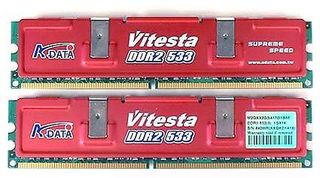Building a Low-Power Home Theater PC System
TV Tuner
It baffles us that anyone who watches TV would ignore the TiVO-like capabilities provided to their HTPC by the simple addition of a TV tuner. We chose the PowerColor Theater 550 Pro PCI-Express x1 card.

Theater 550 based cards have become the TV quality reference product for many sites, though ATI has recently added features in its ATSC-capable TV-Wonder 650. PCI-Express tuners are also available from other ATI partners.
Two tuners are required if you want to be able to view one channel while recording another (or record two programs at once). For builds with limited number of slots, dual-tuner cards are available from PC-TV specialists like AVerMedia and Hauppauge.
Other Components
The rest of our system configuration was gathered from spare parts lying around the office, so anyone starting from scratch could probably come up with something a little more HTPC appropriate. For example, our Western Digital Raptor 150 GB is fast and expensive, but cooler, quieter, and larger drives are generally better suited for storing a collection of large video files. Seagate's 7200.10 750 GB is capable of holding nearly 90 unaltered double-sided DVDs with all the "special features", and two-platter versions featuring lower heat and noise are available at capacities up to 320 GB.
Similarly, our Toshiba SD-R5272 4x DVD burner could have easily been substituted for a now-standard 16x drive or even one of the latest 18x drives from Aopen, Plextor, Samsung, or Sony.
Two components we would likely keep if we were forced to choose again are Cooler Master's iGreen 600W power supply, and our A-Data Vitesta DDR2-533 (PC2-4200) DIMMS - the first for its quiet efficiency, and the second for its low price.

Your choice of power may depend upon your case: the Zalman case we chose supported standard sized (PS/2 form factor) supplies, but not extended length units or those with cables on the right side, due to the shape of its mounting location. Some low-profile cases include customized power units, while others require smaller standards such as SFX or TFX.
Stay on the Cutting Edge
Join the experts who read Tom's Hardware for the inside track on enthusiast PC tech news — and have for over 25 years. We'll send breaking news and in-depth reviews of CPUs, GPUs, AI, maker hardware and more straight to your inbox.
Likewise, DDR2-800 offers a slight performance increase for anyone willing to shell out the extra cash.
Most Popular


